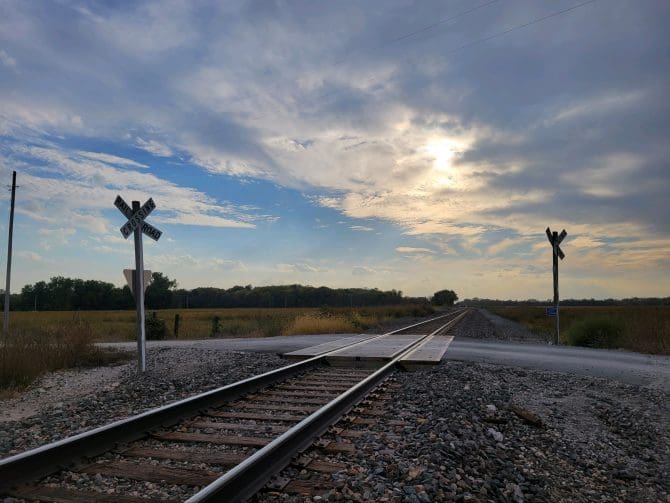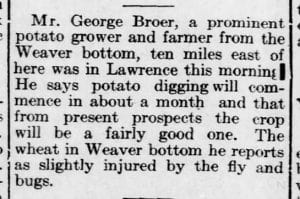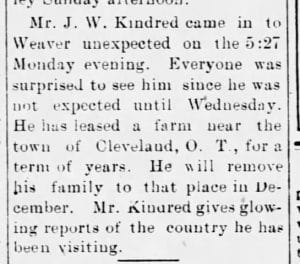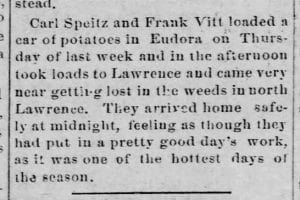Well, it’s that time of year again when everyone starts up the ghost talk. Lawrence has its fair share of haunts, many of which are entertainingly chronicled in Paul Thomas’ Haunted Lawrence, which has recently been adapted for kids. I’m one of those people who would love to see a ghost, but for whom ghosts never show up (I have the same problem with UFOs, Ouija boards, and, up until recently, KU football).
Part of the problem may be that I’m a bit of a stickler for historical accuracy. Years ago when I worked at a library in another city, a patron disclosed they had been seeing the ghostly presence of a librarian who worked in the building for decades and passed away there in the late 1800’s. I loved the idea of that so much I never let on that the building we were in had opened in 1961, and the old library had been 10 blocks away.
Ever since, when I hear about a ghost, I want to see documentation, and this year for Halloween, armed with library science to ward off the darkness, I’m investigating one of Douglas County’s haunted places. So button up your union suits, because it may be a goosebumpy ride.
I had never heard of Weaver Bottom and its resident ghosts until I read Haunted Lawrence. The area, located in a bend of the Kansas River just northeast of Eudora, was once the location of a village called Weaver, named after an early landowner. Farm families grew crops in the rich bottom lands here, and sent their children to the Weaver School, one of rural Douglas County’s earliest, until frequent Kansas River flooding eventually wiped out most traces of the community. Maps, photos of the school and railroad depot, and memories of former residents have been compiled by Margaret Spitzli Gabriel in Weaver, Kansas: A Scrapbook, which can be viewed in the library's Helen Osma Local History Room Vertical Files (in the "Douglas County History" folder), and Weaver School features in Goldie Piper Daniels' Rural Schools and Schoolhouses of Douglas County, Kansas.
Rural Schools and Schoolhouses of Douglas County, Kansas
While it may not be a portal to Hell or a place rockstars visit when they come through Lawrence (unlike another legendary supernatural locale nearby, which shall remain nameless due to the sheer number of Lawrencians who have made nuisances of themselves there, including my own 19-year old self), Weaver Bottom has generated some pretty creepy stories over the years. According to local lore, the area is haunted by the ghost of a young woman who threw herself in front of a train after learning her boyfriend had been killed in World War II, and she can be heard wailing in the dead of night, or seen in one’s rearview mirror where the railroad tracks cross County Line Road.
Thomas writes in Haunted Lawrence that he was unable to locate any news stories about the young woman’s death, but I took a crack at it using the library’s digitized historical newspaper collections. The Kansas Digital Newspapers Program makes over 3 million Kansas newspapers available online, and the searchable NewspaperArchive can be accessed by anyone with a current library card.
Fortunately, I was unable to find coverage of anything remotely like a suicide-by-train. Yes, fortunately. I know ghosts are fun, but come on, folks! The people in these newspapers were real. I did, however, find some intriguing news items about Weaverites of yore who may yet be haunting the Bottom.
To wit, in June 1913, Mr. George Broer told the Jeffersonian Gazette (published out of Lawrence) that potato digging would “commence in about a month and that from present prospects the crop will be a fairly good one,” although, as he put it, the wheat crop in Weaver Bottom had been “slightly injured by the fly and bugs.” Okay, maybe the only interesting thing in this story happened to the wheat.
But how about the fateful ride of J.W. Kindred, reported eerily close to Halloween, on October 29th, 1903, in the Eudora Weekly News? Kindred “came into Weaver unexpected on the 5:27 Monday evening. Everyone was surprised to see him since he was not expected until Wednesday.” And then, well, that's all there is. Handshakes and hugs all around on the platform? Or maybe everyone was annoyed to see him Monday instead of Wednesday. Or maybe "everyone" was just the postman waiting to get a bag of mail from the 5:27 and a stray dog that had been hanging around. At any rate, not much else happened to J.W. Kindred right then.
Here’s one that surely brought some ghosts a-haunting, though. Two young men, Carl Speitz and Frank Vitt, feature in this strange tale told in the Eudora Weekly News of July 24, 1890. After taking a load of potatoes to Lawrence on what seemed like a normal July day, the two “came very near getting lost in the weeds in north Lawrence” before they finally arrived home at midnight. One can only assume they were under the influence of some disorienting supernatural force, and the north Lawrence of 1890 sounds strangely familiar to that of today.
I drove out to Weaver Bottom hoping for some contact with Messrs. Broer, Kindred, Speitz, or Vitt, but all I saw was a lonely railroad crossing, and all I heard was the wind. I arrived before dark, though, and only stayed a few minutes past sundown.
There is actually a scarier, sadder Weaver Bottom ghost story collected in Haunted Lawrence, one which Thomas was even able to back up with his own historical newspaper research, but you’ll have to go check out the book from your local library to hear the rest, as they say. Those ghosts probably don’t show up before midnight, and I don’t stay up that late, or go out of my way looking for scary or sad, since I read plenty of that in the current newspapers. These days I’d rather dig up potatoes than graves, and I’ll take my ghosts as boring as they come.
—Dan Coleman is a Collection Development Librarian at Lawrence Public Library.






Add a comment to: Boring Ghosts of Douglas County